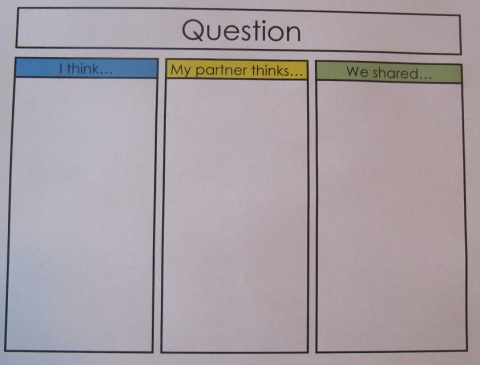Think-Pair-Share

Think-Pair-Share (SDI Productions, iStockphoto)

Think-Pair-Share (SDI Productions, iStockphoto)
How does this align with my curriculum?
PE
5
Integrated Curriculum Grade 5: Science (Draft 2023)
IS 1.4: Collaborating with others effectively can help us to share meaningful explorations in impactful ways.
PE
6
Integrated Curriculum Grade 6: Science (Draft 2023)
IS 1.4: Collaborating with others effectively can help us to share meaningful explorations in impactful ways.
PE
6
Integrated Curriculum Grade 6: Science (Draft 2023)
IS 1.4: Effectively communicate the results of their inquiry.
AB
8
Career and Technology Foundations (CTF) (revised 2019)
CTF is planning, creating, appraising and communicating in response to challenges.
AB
11
CTR2010: Job Maintenance (2016)
Job Maintenance
AB
9
Career and Technology Foundations (CTF) (revised 2019)
CTF is planning, creating, appraising and communicating in response to challenges.
MB
12
Grade 12 Career Development: Life/Work Transitioning (2017)
Unit 1: Personal Management
MB
9
Grade 9 Career Development: Life/Work Exploration (2017)
Unit 1: Personal Management
MB
10
Grade 10 Career Development: Life/Work Planning (2017)
Unit 1: Personal Management
MB
11
Grade 11 Career Development: Life/Work Building (2017)
Unit 1: Personal Management
This strategy helps students develop collaboration skills as they think about topics individually, in pairs and as a large group.
Why use it?
- To provoke students to think individually about a question, an image, a problem or a topic.
- To activate students’ prior knowledge.
- To allow quieter students to engage in personal interactions rather than in front of a larger group.
- To promote higher-level thinking.
- To foster collaboration among students.
Tips for success
- Initially, educators may decide to assign partners rather than letting students choose a partner at random.
- If using this strategy often, ensure that all students are included and that you vary the types of provocations used.
- Give students adequate time for thinking about their own ideas and then, when in partner groups, provide adequate time to both discuss their own ideas and to listen to and respond to their partner’s ideas. You could have students raise their hand or provide another signal that they are finished with their thinking and sharing.
- To limit the discussion of who should go first, when it is time for sharing use clear criteria for directing who will start (e.g., “the person with the longest/shortest hair goes first”, “the person with the darkest/most colourful clothing goes first”).
- Observe and document the partner discussions and the whole class sharing. Ask students to reflect on how well the pairs and shares worked, and any challenges that they encountered throughout the process.
How do I use it?
- Before using this strategy, introduce its purpose to the students and work through an example.
- Pose a question or problem and ask students to think their own response quietly without sharing it with anyone (one to two minutes).
- Once students have had their own quiet and private think time, have each student pair up with a student sitting nearby.
- Have students share their thinking with their partner, taking turns and listening attentively to each other’s ideas.
- Once the students in each pair have had a turn to listen to each other’s ideas, provide partner groups with an opportunity to share their ideas with the larger group. Ask them to discuss whether any of their individual ideas changed after hearing what their partner had to say.
- To encourage active listening skills, you could ask students to tell you something their partners said that was interesting or which made them think about their ideas differently.
Variations
- This strategy could be used to provoke a new interest or to have students reflect on what they have learned.
- Students could draw, sketch or write their responses prior to sharing their thinking with a partners.
- After students have shared their thinking in the first partner group, provide them with a short reflection time and then have them form new partner groups and share their thoughts on the topic with the new partner.
Related Skills
